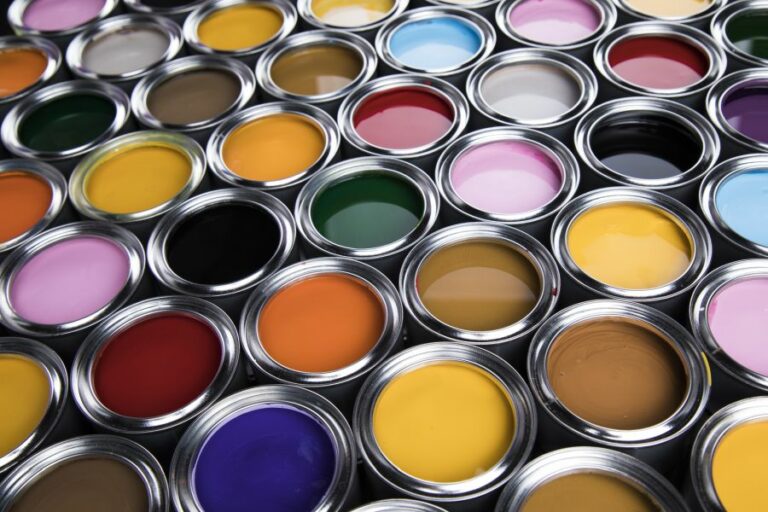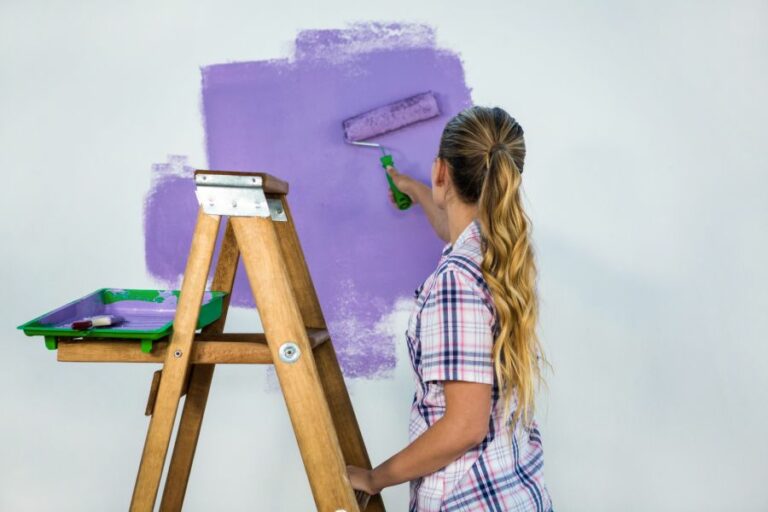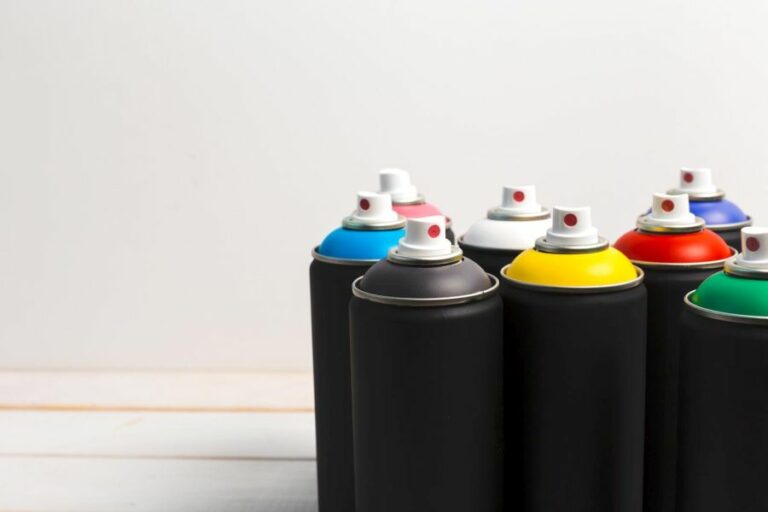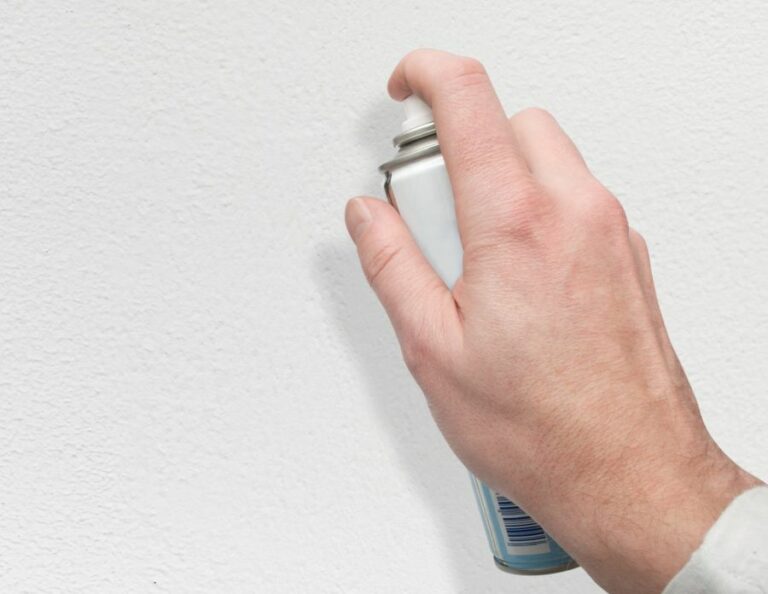Tips For Long-Lasting Spray Paint: Easy Maintenance
Are you tired of your spray paint chipping or fading after just a short time? We have got you covered! With our expert tips on easy maintenance, your spray paint will maintain its vibrant color and luster for the long haul. It’s time to show off your artwork with the confidence that it’ll shine bright like a diamond, and we’re here to ensure just that.
Tips for long-lasting spray paint: easy maintenance:
To ensure long-lasting spray paint, choose high-quality paint and prepare the surface by cleaning, sanding, and applying primer. Use proper application techniques such as ventilation, shaking the can well, maintaining distance and angle, and applying multiple thin coats. Protect the work with a clear coat and follow post-application maintenance by cleaning gently, storing items properly, and repairing chips and scratches when needed.

Want to know more about maintaining the stunning appearance of your spray paint projects? We’ve got you covered! Discover additional tips and tricks for long-lasting spray paint and easy maintenance just ahead. Keep reading to unlock the full potential of your spray paint projects!
Contents
- 1 Prolonging Spray Paint Life: Maintenance Techniques
- 2 Methods for Extending the Lifespan of Spray Paint
- 3 Preserving Your Spray Paint: Care and Upkeep
- 4 Reasons Behind Spray Paint’s Short Lifespan and Solutions
- 5 Spray Paint Durability: Expected Years of Lasting
Prolonging Spray Paint Life: Maintenance Techniques
Spray paint is a versatile and convenient way to transform a variety of surfaces. With proper application and maintenance, the results can last for many years.
• Choose Quality Spray Paint
When selecting spray paint, it is crucial to prioritize quality. Through using high-quality paint, not only will you achieve better coverage and better results, but it will also ensure long-lasting appeal.
Look for well-known brands, and read reviews from professional artists or reputable sites like ArtistsNetwork to evaluate the best products. High-quality spray paint may be more expensive, but it is an investment in the longevity of your work.
• Surface Preparation
– Clean the Surface
Before spray painting, thoroughly clean the surface to remove any dust, dirt, or grease. This ensures that the paint adheres properly to the surface and will increase the paint’s longevity. Use a mild detergent or degreaser, and ensure that the surface is completely dry before applying paint.
– Sand the Surface
For an even application and a long-lasting finish, sand the surface with medium-grit sandpaper before painting. This helps the paint bond more securely to the surface and gives a smoother final result.
– Apply Primer
A primer is necessary, especially when painting on porous surfaces, such as wood, because it helps the paint adhere better and last longer. Choose a primer that is specifically designed for use with spray paint or surface material.
• Proper Application Techniques
– Proper Ventilation
Make sure to work in well-ventilated areas when using spray paint. In addition to protecting your health from harmful fumes, proper ventilation ensures that the paint dries correctly and avoids any adverse effects on the final result.
– Shake the Can Well
Shaking the can vigorously for at least one minute ensures that the paint mixes evenly, which contributes to a more consistent and long-lasting finish.
– Maintain Proper Distance and Angle
Hold the spray paint can about 10-12 inches away from the surface and at a consistent angle. This allows for an even and smooth layer of paint, which is crucial for achieving long-lasting results.
– Apply Multiple Thin Coats
Do not apply one thick coat of paint; instead, opt for multiple thin layers. This allows the paint to dry more evenly and creates a more durable finish. Allow each coat to dry completely before applying the next one, as this helps prevent cracking and peeling in the long run.
• Protect Your Work with Clear Coat
Applying a clear coat over your spray paint is essential for long-lasting results. A clear coat not only provides an additional layer of protection from scratches and fading but also gives your work a more professional finish.
Choose a clear coat that is specifically designed for use on spray-painted surfaces or from the same brand as your spray paint.
• Post Application Maintenance
– Cleaning Your Spray-Painted Surface
When cleaning your spray-painted surface, avoid using harsh chemicals or abrasive materials, as they can damage the paint. Instead, use a mild detergent or soap and water with a soft cloth.
For stubborn stains, a small amount of rubbing alcohol can be applied with a soft cloth, but test on a hidden area first to ensure it does not affect the paint.
– Store Your Spray Painted Items Properly
If possible, store your painted items indoors, away from direct sunlight and extreme temperatures. This helps to prevent fading and extends the life of your paint.
– Repairing Chipped or Scratched Paint
If your spray paint gets chipped or scratched, consider lightly sanding the affected area and applying a touch-up coat of paint. Use the same brand and color for a seamless finish.
• Final Thoughts
Spray paint is an excellent medium for various artistic purposes and practical applications. By utilizing quality products, proper tools, and mindful techniques, you can achieve impressive, long-lasting results.
Following the easy maintenance principles outlined in this article will help to extend the life of your spray paint creations, allowing you to enjoy them for many years to come.
Methods for Extending the Lifespan of Spray Paint
Spray paint is a versatile and convenient tool used by artists, DIY enthusiasts, and professionals alike. While it is prized for its ease of use and relatively low cost, one drawback is that spray paint can sometimes have a short lifespan.
Here are some valuable tips and techniques to lengthen the life of your spray paint, ensuring the maximum value and longevity of your projects.
• Proper Storage Conditions
To maintain the quality of your spray paint, it is essential to store it under the right conditions. Many factors can affect the longevity and function of your spray paint, such as temperature, humidity, and exposure to direct sunlight.
– Temperature Control
Spray paint should be stored at room temperature, ideally between 60-80F (15-27C). Extreme temperatures can lead to changes in pressure and viscosity, affecting the performance of your spray paint.
– Humidity Management
High humidity levels can cause moisture to enter the can, leading to rust and paint clumping. To prevent these issues, store your spray paint in a dry and well-ventilated area. Using silica gel packets or a dehumidifier can help maintain optimal moisture levels.
– Limit Sunlight Exposure
Direct sunlight can cause spray paint to deteriorate more quickly. Store your cans in a cool, dark place away from windows, and avoid leaving them outside exposed to sunlight for prolonged periods.
• Appropriate Preparation of Surfaces
Before applying spray paint to any surface, ensure that it is clean, dry, and free from grease, dirt, and dust. This will allow the paint to adhere properly, preventing peeling or flaking over time.
– Surface Cleaning
Use a mild detergent and warm water to clean the surface. Rinse thoroughly and allow it to dry completely before applying any paint. If you encounter dirt or oil, consider using a degreaser or specialized cleaning product to ensure an immaculate surface.
– Sanding
For rough or uneven surfaces, lightly sand the area with fine-grit sandpaper (120-220 grit). This will create a smoother surface and improve paint adhesion. After sanding, wipe the surface with a tack cloth to remove any remaining dust particles.
• Using Quality Paint and Equipment
When it comes to spray paint, not all products are created equal. Investing in quality paint and equipment can have a substantial impact on the longevity and appearance of your projects.
– Choose High-Quality Paint
Select a reputable brand known for its durability and high-quality pigments. These paints often last longer and provide a more consistent finish. Look for features such as UV resistance, weather resistance, and non-yellowing properties.
– Use the Right Nozzle Type
Spray paint nozzles come in various sizes and shapes, each suited to different applications. Be sure to use the appropriate nozzle for your specific project. A good-quality nozzle will provide an even and consistent spray pattern, leading to a longer-lasting and better-looking result.
– Invest in a Grip Handle
A grip handle attachment can help maintain an even spraying motion, reducing the risk of drips or uneven coverage. This accessory can also minimize hand fatigue and make the spraying process more comfortable.
• Proper Application Techniques
Using correct application techniques can significantly impact the longevity of your spray paint finish. Follow the guidelines below for optimal results.
– Apply Thin, Even Coats
Slow and steady wins the race when it comes to spray paint. Apply thin, even coats, allowing each layer to dry fully before adding the next. This will create a durable and consistent finish that is less likely to crack, peel or chip.
– Maintain the Correct Distance
When spraying, hold the can 8-12 inches (20-30 cm) away from the surface. This distance ensures even coverage and reduces the risk of drips, runs, or bubbling.
– Shake the Can Well
Before starting your project, shake the spray paint can vigorously for at least 1 minute. This helps to mix the paint and propellant properly, ensuring a smoother and more consistent application.
• Protecting Your Finished Projects
Once your spray paint has been applied and allowed to dry fully, it’s essential to take steps to protect the finish and ensure its longevity.
– Apply a Clear Sealer
A clear sealer, available in both matte and gloss, can help protect your spray paint finish from UV rays, weather, and scratches. Ensure the sealer is compatible with your paint and follow the manufacturer’s instructions for optimal results.
– Handle with Care
Even after the paint has dried, it remains susceptible to damage, particularly in the first few weeks. Handle your freshly painted projects with care, and avoid exposing them to harsh or abrasive environments.
In conclusion, making your spray paint last longer is achievable through proper storage, surface preparation, choosing quality paint and equipment, correct application techniques, and protective measures.
By following these tips and techniques, you can ensure that your spray painting projects have an extended lifespan, saving you time, money, and effort.
| How to Make Spray Paint Last Longer | |
|---|---|
| 1. Properly prepare the surface | Before painting, clean the surface thoroughly and make sure it is dry, smooth, and free of dust, dirt, or grease. |
| 2. Shake the can well | Shake the spray paint can for at least one minute to mix the paint and ensure a smooth and even application. |
| 3. Apply multiple thin layers | Instead of spraying one thick coat, apply multiple thin layers, allowing each layer to dry before applying the next one. This will increase the paint’s durability and reduce the chances of it chipping or peeling. |
| 4. Maintain a proper distance | Hold the spray paint can at least 6-8 inches away from the surface to prevent drips and ensure a smooth, even finish. |
| 5. Use a clear topcoat | Apply a protective clear topcoat or sealer after the paint has dried to increase durability and protect against the elements. |
| 6. Store the can properly | After use, store the spray paint can in a cool, dark place with the nozzle covered to extend its shelf life. |
Preserving Your Spray Paint: Care and Upkeep
Spray paint is a versatile and affordable tool used by artists, DIY enthusiasts, and professionals alike. However, to ensure a flawless paint job and minimal frustration, it’s crucial to understand how to maintain and care for your spray paint cans.
By following proper storage, cleaning, and application techniques, your spray paint is sure to provide lasting, high-quality results.
• Storing Your Spray Paint Cans
To prolong the life of your spray paint and ensure it performs optimally, proper storage is essential. Follow these guidelines for the best results:
– Store in a Cool, Dry Place
Extreme temperatures can degrade the paint and ultimately ruin it. Keep your spray paint cans in a cool, dry and well-ventilated area, away from direct sunlight or heat sources. Experts recommend staying within a temperature range of 50 to 85 degrees Fahrenheit.
– Keep It Upright
Always store your spray paint cans in an upright position, with the nozzle facing upwards. This helps prevent paint from clogging the nozzle and ensures the even distribution of pigments and propellants within the can.
– Don’t Store Near Open Flames
Spray paint is flammable, so avoid storing it near open flames, furnaces, or other sources of ignition. Make safety a priority when choosing your storage location.
• Cleaning Your Spray Paint Nozzles
A clean nozzle is essential for even coverage and smooth application. To prolong the life of your nozzles and ensure consistent paint flow, follow these cleaning tips:
– Clear the Nozzle After Each Use
After you finish a spray paint project, it’s crucial to clear the nozzle to prevent clogging. To do this, invert the can and press the nozzle until only clear gas is released. This should only take a few seconds.
Note: Some sources, such as Berkeley.edu, recommend never spraying empty cans on the ground, as the residual paint could pose a health or environmental risk. Always dispose of spray cans responsibly.
– Soak Clogged Nozzles
If a nozzle becomes clogged, remove it from the can and soak it in a small container of paint thinner or mineral spirits for several hours or even overnight. This should loosen any dried paint and allow you to clean the nozzle with a small brush or cotton swab.
– Swap Out Nozzles
If you have multiple cans of the same brand, consider swapping nozzles between cans to ensure they all receive equal use and cleaning.
• Proper Application Techniques
Good application habits not only produce better results but also prevent paint waste and nozzle damage. Keep the following tips in mind when using spray paint:
– Shake Well
Before using a spray paint can, shake it thoroughly for at least one minute. This ensures even pigment distribution, and optimal paint flow and helps minimize the risk of clogging.
– Test Your Spray
Before applying paint to your project, always do a test spray on a piece of scrap material, cardboard, or newspaper. This ensures the paint is flowing correctly and helps you get a feel for the spray pattern.
– Use Light, Even Coats
When applying spray paint, use light, even coats in a sweeping motion to achieve a smooth, consistent finish. Holding the can too close or using a heavy hand can result in drips, uneven coverage, and wasted paint.
– Keep the Nozzle Clean During Application
If you notice the paint flow diminishing or the spray pattern becoming inconsistent during the application, clean the nozzle by inverting the can and spraying until only clear gas is released.
• Disposing of Spray Paint Cans
Once your spray paint is depleted, it’s essential to dispose of the can responsibly. Empty cans are still considered hazardous waste due to residual paint and propellants. If possible, recycle your cans by following your local recycling guidelines or utilizing a hazardous waste collection program.
In conclusion, maintaining spray paint is not a complicated process, but it does require diligence and good habits. By following proper storage, cleaning, application, and disposal techniques, you can enjoy the benefits of high-quality, lasting results from your spray paint projects.
Step | Description |
|---|---|
1. Shake well before use | Shake the spray paint can for at least one minute before using it to ensure the paint is properly mixed. |
2. Test spray | Before applying the spray paint to your project, test it on a scrap piece of material to ensure proper spray pattern and color. |
3. Maintain proper distance | Hold the can approximately 10-12 inches away from the surface to be painted. This will aid in preventing drips and uneven coverage. |
4. Apply multiple thin coats | Instead of applying one thick coat of spray paint, opt for multiple thin coats. Allow each coat to dry before applying the next one. |
5. Clean the nozzle | After using the spray paint, invert the can and spray for a few seconds to clear the nozzle of any residual paint. This will help prevent clogs. |
6. Store properly | Store spray paint cans in a cool, dry place away from heat sources and direct sunlight. Don’t store them upside down. Make sure the cap is on securely. |
Reasons Behind Spray Paint’s Short Lifespan and Solutions
As an experienced painter, I have observed that many people face issues with their spray paint coming off easily, leading to dissatisfaction with the final result.
• Insufficient Surface Preparation
One of the main reasons why spray paint comes off easily is due to the lack of proper surface preparation. For a successful spray-painting job, it is essential to thoroughly clean and prepare the surface to ensure proper adhesion of the paint.
- Cleaning: Remove all dirt, dust, or any other surface contaminants by wiping the surface with a clean, damp cloth. For stubborn stains or grease, I recommend using a mild detergent or a recommended cleaning agent to ensure a spotless surface.
- Sanding: Sanding the surface with appropriate sandpaper (usually 180-220 grit) is crucial to create a smooth, paint-ready surface. Sanding removes any existing paint, rough spots, and imperfections, thus allowing the paint to adhere better.
- Priming: Applying a primer before painting can significantly improve paint adhesion and durability. Choose a primer specifically designed for the material you are working with, such as metal, wood, or plastic, to achieve the best results.
• Improper Paint Selection
Another common issue leading to spray paint coming off easily is the use of inappropriate paint for the given surface. Different materials require specific types of paint to ensure proper bonding and durability.
- Paint Compatibility: Always make sure to choose a paint that is specifically designed for the material you are working on, be it metal, wood, plastic, or any other surface. Using an incompatible paint type will result in weak adhesion and easy peeling.
- Paint Quality: High-quality paints have better adhesion properties and are more durable. Thus, opting for a renowned brand or paint variety ensures better overall results and longevity.
• Insufficient Drying Time
Allowing ample time for the paint to dry between layers is crucial for ensuring strong adhesion and avoiding paint removal issues.
- Between Coats: Follow the manufacturer’s recommendation for drying time between coats. Usually, it takes about 30 minutes to 1 hour for each layer of paint to dry, depending on the ambient conditions.
- After the Final Coat: Allow sufficient time for the final coat to dry before exposing the painted surface to usage, moisture, or any other external factors. This may take up to 24 hours or more, depending on the paint type and weather conditions.
• Environmental Factors
Temperature, humidity, and other environmental factors can significantly affect the adhesion, drying time, and overall performance of spray paint.
- Temperature: Ideal spray-painting conditions are typically between 50F and 90F (10C and 32C). Too cold or too hot temperatures can result in poor paint adhesion, longer drying times, or other paint issues.
- Humidity: High humidity levels can prolong the drying time and negatively impact the paint’s adhesion properties. It is best to avoid painting on extremely humid days or in areas prone to high moisture levels.
• Application Technique
The application technique and overall handling of the spray paint can also contribute to the paint coming off easily.
- Spray Distance: Maintain a consistent distance of approximately 10-12 inches from the surface while painting. Spraying too close may cause paint to build up in one area, while spraying too far away may result in a weak, uneven coat.
- Coat Thickness: Apply multiple thin coats rather than a single thick coat, allowing sufficient drying time between coats. Thick coats may lead to incomplete curing or poor adhesion of the paint.
In conclusion, surface preparation, paint selection, drying time, environmental factors, and application technique are critical aspects to consider when spray painting.
By addressing these issues, you can achieve a quality finish that won’t come off easily. Remember always to follow the manufacturer’s instructions and expert recommendations for optimal results.
Spray Paint Durability: Expected Years of Lasting
Spray paint is a popular medium for both professional artists and DIY enthusiasts due to its ease and convenience of use. However, a common question that is often asked is how many years spray paint lasts after its application.
• Factors Affecting Spray Paint Longevity
There are various factors that can impact the lifespan of spray paint, including the surface it is applied to, the environment in which it is used, and the quality of the paint itself. Understanding these factors can help you determine how long your spray paint project will remain vibrant and in good condition.
– Surface Material
The type of surface on which the spray paint is applied is a significant factor in determining its longevity. Certain materials, such as metal, plastic, and wood, will have different rates of absorption and adherence when it comes to spray paint.
For example, painting on metal can often result in a more durable and longer-lasting finish compared to painting on plastic.
On the other hand, painting on wood can cause the paint to absorb into the material, potentially leading to a shorter life span. Thus, it is crucial to consider the nature of the surface on which you plan to apply spray paint.
– Environmental Factors
The environment in which the spray paint is applied and the painted object is located significantly affects the paint’s lifespan. Factors such as temperature, humidity, and sun exposure play a role in determining how long the paint lasts.
For example, direct sun exposure can cause the paint to fade and lose its vibrancy over time. Furthermore, extreme temperatures and fluctuations between hot and cold can cause the paint to expand and contract, leading to cracking and peeling.
It is essential to consider the environment in which your painted project will be stored or displayed, as well as take measures to protect it from adverse environmental conditions.
– Quality of Spray Paint
The quality of the spray paint you choose also plays a role in how long it lasts. Higher-quality paint often has better-adhesion properties and is more resistant to environmental factors, such as UV rays and temperature fluctuations.
Moreover, some spray paints are formulated explicitly for certain types of surfaces, such as metal or plastic. Selecting a paint specifically designed for your project’s surface material can lead to a longer-lasting finish.
I recommend opting for a reputable brand and selecting a paint that suits your specific project to ensure the best results.
• Spray Paint Lifespan Estimates
With these factors in mind, it can be challenging to provide a definitive answer to the question of how many years spray paint lasts. However, here are some general estimates based on the factors mentioned above:
- Interior projects on non-porous surfaces, such as metal or plastic, can last around 10-15 years if well-maintained and keep away from direct sun exposure.
- Exterior projects, depending on the environmental conditions, can last between 3-10 years.
- Wood surfaces, due to their porous nature, may only last around 5-7 years.
These estimates can vary based on the specific circumstances surrounding your project, such as the quality of the paint, surface preparation, and environmental factors.
• Recommendations for Prolonging Spray Paint Life
To ensure your spray paint project lasts as long as possible, consider the following recommendations:
- Proper surface preparation: Thoroughly clean and prime the surface before painting to ensure proper paint adhesion.
- Use high-quality paint: Opt for a reputable brand and select a paint that suits your specific project type.
- Apply multiple coats: Applying several layers of paint can help improve durability and longevity.
- Protect the paint: For outdoor projects, consider using a clear topcoat or sealant to protect the paint from sun exposure and other environmental factors. For indoor projects, keep the painted object away from direct sunlight or excessive heat.
By following these recommendations, you can maximize the lifespan of your spray paint projects and enjoy their beauty for years to come.
• In Conclusion
The longevity of spray paint can vary significantly based on factors such as surface material, environmental conditions, and the quality of the paint used.
While there is no one-size-fits-all answer to the question of how many years spray paint lasts, with proper care and consideration of these factors, your painted projects can continue to look vibrant for many years.







